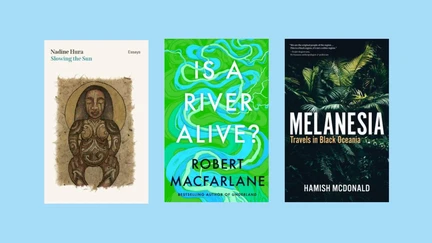This Month's Popular Non-Fic Picks
Check out some of the books recently added to the non-fiction collection.

The books on this list cover a wide range of topics, but the thing they all have in common is approachability and passion: they are perfect for anyone new to their subjects. Read on and you will discover raging rivers, influential maps, and four thousand year old relics - and that's just scratching the surface.
- Slowing the sun : essays / Hura, Nadine
This essay collection from Nadine Hura is a blended work that masterfully threads science writing, pūrākau and poetry together, resulting in a vulnerable and deeply humanising response to the climate crisis. Hura goes far beyond that topic alone, recognising the role the far-reaching ravages of colonialism have played in the current state of the environment. The book’s heart is centred in te ao Māori, reaffirming the centrality of Te Tiriti and anti-colonialism in climate and social justice, and Hura’s essays and poetic vignettes are multi-faceted and poignant as she explores grief both old and new. This is must-read climate writing grounded in the communities and histories of Aotearoa.
- Is a river alive? / Macfarlane, Robert, 1976-
In 2017 the Whanganui River was the first river in the world to be granted legal personhood. Since then, a number of other rivers around the world have been granted similar status, but for many more the battle has just begun. In Is a River Alive? renowned nature writer Robert Macfarlane takes us on a journey from Ecuador to India and then to Quebec, introducing us to lifegiving rivers and the people who are fighting to protect them from exploitation and destruction. It is a beautiful, illuminating book that challenges our assumptions about what counts as life and what deserves to be protected, while immersing us in the rich and entangled world of rivers.
- Everything is tuberculosis : the history and persistence of our deadliest infection / Green, John, 1977-
Tuberculosis seems like a disease of the past, and these days it is curable – but for many it continues to be a dangerous reality, killing over a million people every year. John Green, upon meeting Henry Reider, a young boy hospitalised with tuberculosis, set out to learn more about this disease and why it persists. This book is the result. It is a readable, informative, and important chronicle of this deadly disease, from (mis)treatments throughout history, to the social forces that keep it spreading in the present. Ultimately, it is a call to action, and Green’s dedication to bring light to the issue shines through.
- Between two rivers : ancient Mesopotamia and the birth of history / Al-Rashid, Moudhy N. (Moudhy Nasser), 1982-
This book is perfect for anyone interested in ancient history and archaeology. In each chapter, historian Moudhy N. Al-Rashid takes a closer look at an artefact from ancient Mesopotamia, using these objects as focal points to reveal what we can of the lives of the people who left them behind. It is a fascinating history that moves from the cuneiform writing of ancient bureaucrats to the imprints of a child’s teeth in clay, all the while being passionately written and informative. Al-Rashid makes the distant past feel close, populated with people more similar to ourselves than we might expect.
- Mapmatics : how we navigate the world through numbers / Rowińska, Paulina
Calling all map enthusiasts, dabblers in mathematics, and devotees of niche topics made accessible! This book is all about the entwined development of cartography and maths, with Dr Paulina Rowińska as our worthy guide. She makes the material come to life through amusing and compelling anecdotes, exploring how our societies have been shaped by the way we map our world. It’s never dry – in fact, it’s constantly surprising, taking us from places we know well, such as city roads and railways, to the less familiar: the bottom of the ocean, the earth’s core, the vital lines of a spreading epidemic. Don’t worry if you’re not a maths whiz, you’re in safe hands on this journey.
- Melanesia : travels in Black Oceania / McDonald, Hamish, 1948-
Part travelogue and part history book, and with a good amount of political analysis too, this is all about our near neighbours in the Pacific: the many diverse nations that make up Melanesia. Australian journalist Hamish McDonald sails, tramps and hitchhikes across a number of islands where he talks to locals of all stripes, bringing their insights and experiences to the forefront of the book. Billed as a great introduction to these islands for anyone curious or unfamiliar, McDonald crafts a snapshot of the region as it is today, with sensitivity to the ways Melanesia has been portrayed and exploited by outsiders in the past – and present.